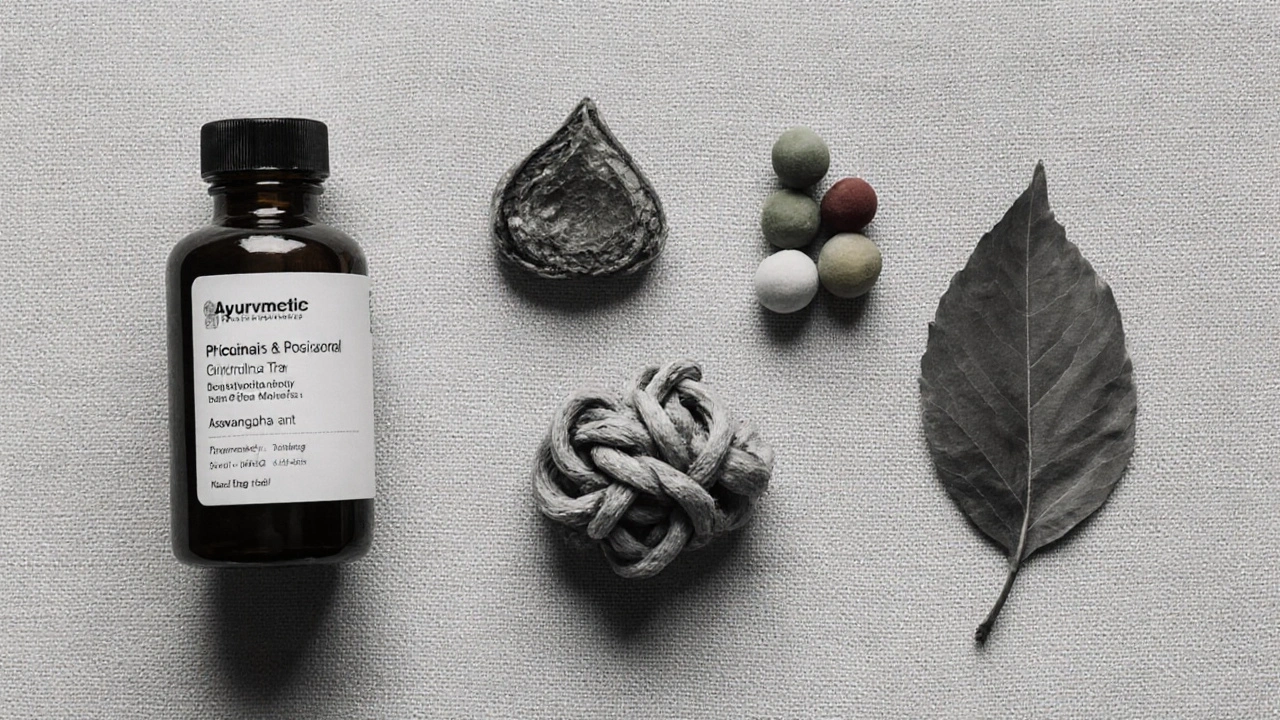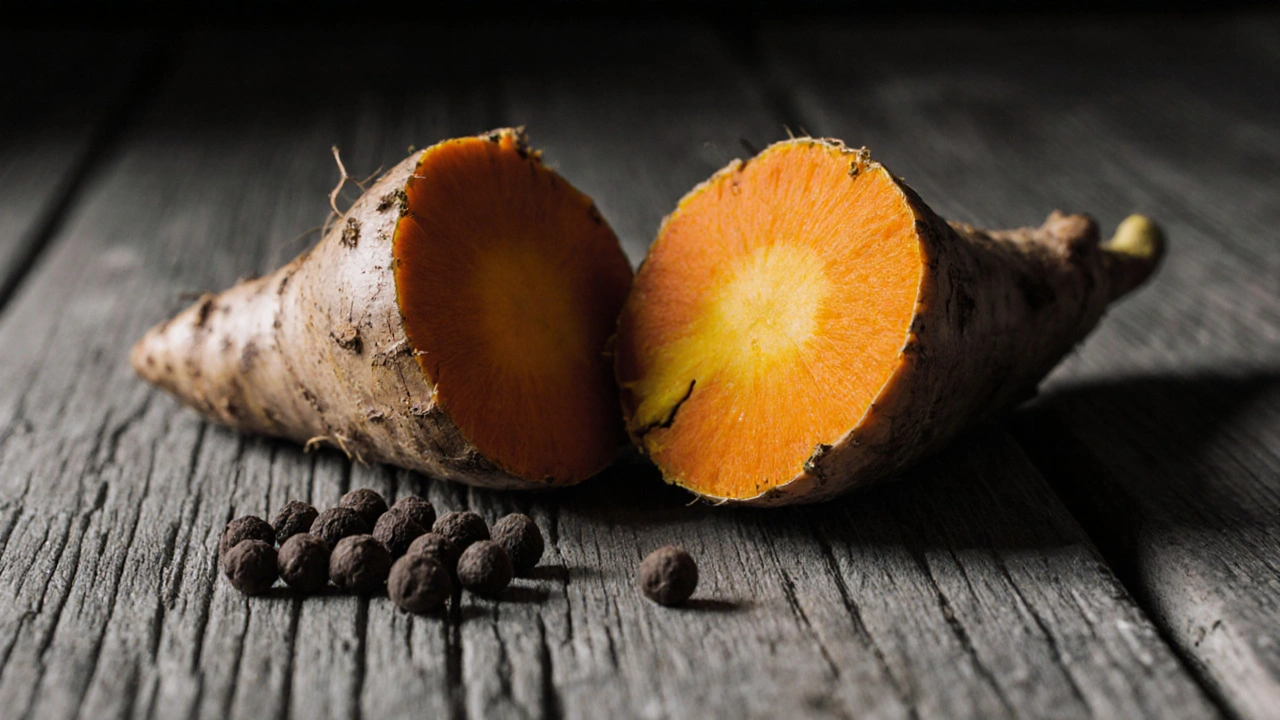Ayurvedic Supplement Recommender
This tool helps you select the most appropriate Ayurvedic supplement based on your primary health goal. Enter your preferences to get personalized recommendations.
What is your primary health goal?
Key Takeaways
- Haridra’s active compound curcumin offers strong anti‑inflammatory benefits, but its bioavailability is low without piperine.
- Boswellia provides comparable joint relief with better gut tolerance, while Ashwagandha adds adaptogenic stress support.
- Triphala excels at digestive health and antioxidant protection, making it a good complement rather than a direct substitute.
- Choosing the right alternative depends on your primary health goal-pain relief, stress reduction, or digestive balance.
- Combining Haridra with black‑pepper extract or a lipid carrier can boost absorption to match or exceed many alternatives.
When you hear the name Haridra (Turmeric) is a bright yellow rhizome long used in Ayurvedic medicine for its anti‑inflammatory and antioxidant properties, you probably picture golden milk or a spice rack. But today, Haridra supplement users are looking for a clear answer: how does it stack up against other herbal options for joint pain, inflammation, and overall wellness? This guide breaks down the science, the strengths, and the drawbacks of Haridra and five popular alternatives-Curcumin extracts, Boswellia, Ashwagandha, Triphala, and Neem-so you can pick the right plant power for your needs.
Understanding Haridra: What Makes It Unique?
Haridra’s claim to fame lies in Curcumin is the bright orange polyphenol responsible for most of turmeric’s therapeutic actions. Curcumin inhibits the COX‑2 enzyme, lowering inflammatory mediators like prostaglandins. It also scavenges free radicals, supporting cardiovascular health and cellular aging.
However, curcumin is notoriously poorly absorbed. Studies from the Indian Council of Medical Research (2023) show oral bioavailability can be as low as 1% without a carrier. That’s why many high‑quality Haridra supplements pair the powder with Piperine is an alkaloid from black pepper that boosts curcumin absorption up to 2000% or encapsulate the extract in liposomal or phytosomal forms.
Alternative #1: Curcumin Extracts
Pure curcumin extracts isolate the active molecule, often delivering 95% standardized concentration. Brands like Meriva and Theracurmin use phytosome technology to attach curcumin to phospholipids, dramatically improving bioavailability. In a 2022 double‑blind trial, participants taking phytosomal curcumin reported a 45% reduction in knee pain versus placebo.
While curcumin extracts match Haridra’s core benefits, they lose the synergistic matrix of other turmeric compounds-demethoxycurcumin and turmeronols-that may provide added antioxidant buffering. If you only need a high‑dose anti‑inflammatory without the spice flavor, a standardized extract is a solid choice.
Alternative #2: Boswellia serrata (Indian Frankincense)
Boswellia is a resin from the Boswellia tree known for its potent anti‑inflammatory boswellic acids. Boswellic acids inhibit 5‑lipoxygenase, targeting a different inflammatory pathway than curcumin. Clinical data (Journal of Ethnopharmacology, 2021) shows Boswellia can reduce rheumatoid arthritis DAS‑28 scores by 30% in 12 weeks.
The biggest advantage over Haridra is gastrointestinal tolerance-Boswellia rarely causes the mild stomach upset some turmeric users experience. On the downside, Boswellia lacks the broad antioxidant profile of curcumin, so its cardio‑protective effects are less pronounced.
Alternative #3: Ashwagandha (Withania somnifera)
Ashwagandha is an adaptogenic root that helps the body cope with stress and supports muscle recovery. While not a traditional anti‑inflammatory, Ashwagandha reduces cortisol, which indirectly lowers systemic inflammation. A 2023 meta‑analysis found a 22% drop in C‑reactive protein (CRP) among supplement users.
For athletes or anyone battling chronic stress, Ashwagandha can complement Haridra’s joint support. However, it doesn’t provide the same targeted COX‑2 inhibition, so it’s not a straight‑up replacement for pain relief.

Alternative #4: Triphala
Triphala is a blended formula of three fruits-Amla, Haritaki, and Bibhitaki-used for digestive health and antioxidant defense. Its polyphenols rival curcumin’s free‑radical scavenging capacity. In a 2022 gut‑microbiome study, Triphala increased beneficial Lactobacillus levels by 18% and lowered markers of intestinal inflammation.
Triphala shines when you need gut support alongside inflammation control. It’s less potent for acute joint pain, making it a complementary, not competing, supplement.
Alternative #5: Neem (Azadirachta indica)
Neem is a tree leaf extract prized for antimicrobial, anti‑inflammatory, and skin‑healing properties. Neem’s nimbidin compound blocks NF‑κB signaling, a key inflammatory cascade. Small clinical trials (Ayurvedic Journal, 2020) show neem oil topicals reduce psoriasis plaque thickness by 40%.
Neem is ideal for skin‑related inflammation but is less studied for systemic joint pain. Pairing neem with Haridra could give a dual skin‑joint benefit, yet neem alone won’t replace Haridra’s broad systemic effects.
Comparative Overview
| Feature | Haridra (Turmeric) | Curcumin Extract | Boswellia | Ashwagandha | Triphala |
|---|---|---|---|---|---|
| Main Active Compound | Curcumin + minor curcuminoids | 95% curcumin (standardized) | Boswellic acids | Withanolides | Amla, Haritaki, Bibhitaki polyphenols |
| Primary Benefit | Anti‑inflammatory & antioxidant | Potent anti‑inflammatory (high dose) | Joint pain relief (COX‑independent) | Stress reduction, muscle recovery | Digestive health & antioxidant |
| Bioavailability (standard form) | ~1% (needs piperine/liposome) | ~5‑10% (phytosome up to 40%) | ~30% | ~12% | ~15% |
| Typical Dose | 500‑2000mg turmeric powder | 400‑600mg curcumin | 300‑500mg boswellic acids | 300‑500mg extract | 1‑2g powder |
| Common Side Effects | Mild stomach upset, possible gallstone risk | Rare GI upset | Occasional nausea | Drowsiness at high doses | Rare constipation |
| Best For | General inflammation, cardio‑health | Targeted joint pain, high‑dose therapy | Arthritis, gut‑friendly option | Stress, adrenal support | Digestive balance, antioxidant boost |
How to Choose the Right Supplement
1. Identify your primary goal. If joint pain is the main issue, Haridra or Curcumin extracts are front‑runners. For stress‑related inflammation, consider Ashwagandha.
2. Check bioavailability. Pure Haridra powder needs piperine or a liposomal delivery system. If you prefer a ready‑to‑go solution, go for a phytosomal curcumin product.
3. Assess gut tolerance. Some users report turmeric‑induced indigestion. Boswellia offers comparable pain relief with a gentler stomach profile.
4. Look at complementary benefits. Pairing Haridra with Triphala can give you joint relief plus digestive health, while adding neem can enhance skin benefits.
5. Consider dosage convenience. Capsules, tablets, or powders each have pros and cons for daily adherence. Choose a format that fits your routine.
Potential Pitfalls and Pro Tips
- Don’t ignore interactions. Haridra can increase bleeding risk when combined with anticoagulants like warfarin.
- Watch for adulterated products. Choose third‑party tested brands to avoid fillers or synthetic dyes.
- Mind the timing. Taking curcumin or Haridra with a fatty meal improves absorption dramatically.
- Cycle high‑dose regimens. Some users rotate Haridra with Boswellia every 8‑12 weeks to prevent tolerance.
Quick Decision Tree
- Is joint pain your top concern?
- Yes → Choose Haridra with piperine or a phytosomal Curcumin extract.
- No → Go to step 2.
- Do you have a sensitive stomach?
- Yes → Boswellia or a low‑acid Haridra formulation.
- No → Continue.
- Do you need stress/adrenal support?
- Yes → Add Ashwagandha (can be stacked with Haridra).
- No → Consider Triphala for gut health or Neem for skin.
Frequently Asked Questions
Can I take Haridra and Boswellia together?
Yes, the two work on different inflammatory pathways, so stacking can provide broader relief. Start with low doses and monitor tolerance.
Is piperine necessary for all Haridra supplements?
If the product is plain turmeric powder, piperine or a fat source is crucial for absorption. Extracts that use phytosome or liposomal technology may not need extra piperine.
How long does it take to notice benefits?
Most users report reduced joint stiffness within 2-4 weeks of consistent dosing, while antioxidant effects on skin may take 6-8 weeks.
Are there any contraindications for Ashwagandha?
Ashwagandha can lower thyroid hormone levels, so people on thyroid medication should consult a doctor before starting.
What’s the best way to store Haridra powder?
Keep it in an airtight container, away from light and heat. A cool pantry or refrigerator shelf works best.
Bottom Line
Haridra remains a versatile, whole‑food anti‑inflammatory powerhouse, but its effectiveness hinges on absorption. If you need a high‑dose, fast‑acting solution, a phytosomal curcumin extract may win out. For gut‑friendly joint support, Boswellia shines, while Ashwagandha adds stress resilience. Triphala and Neem serve niche needs like digestion and skin health. By matching the supplement’s strengths to your personal health goals, you can get the most bang for your buck and avoid common pitfalls.





bhavani pitta
October 15, 2025 AT 21:22While many herald turmeric as the quintessential anti‑inflammatory, it is imperative to acknowledge that its efficacy is markedly constrained without an appropriate bio‑enhancer. The low inherent bioavailability renders plain Haridra a sub‑optimal choice for acute joint discomfort. Moreover, alternative botanicals such as Boswellia present comparable benefits with a more favorable absorption profile. Consequently, one should exercise discernment before privileging Haridra over its counterparts.
Brenda Taylor
October 30, 2025 AT 12:22lol these supplements sound like a witch‑craft market 😂
virginia sancho
November 14, 2025 AT 04:22If you’re lookin for a cheap way to boost the curcumin, try mixin it with a spoonfull of olive oil and a pinch of black pepper. The fat helps the curcumin dissolve and piperine spikes the uptake. I’ve seen people get decent joint relief in about two weeks. Just dont expect miracle results overnight. Keep track of any stomach upset, it can happen.
Namit Kumar
November 28, 2025 AT 20:22From an Indian perspective, turmeric has been used for millennia; its cultural relevance adds value beyond mere bio‑availability 📈. However, modern formulations do aim to overcome the absorption barrier.
Sam Rail
December 13, 2025 AT 12:22Sounds fancy, but I’d just grab a bottle of ibuprofen.